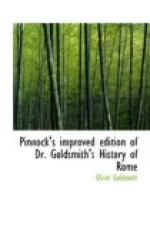8. Con’stantine being thus become sole monarch, resolved to establish Christianity on so sure a basis that no new revolution should shake it. He commanded that, in all the provinces of the empire, the orders of the bishops should he implicitly obeyed. He called also a general council, in order to repress the heresies that had already crept into the church, particularly that of A’rius. 9. To this council, at which he presided in person, repaired about three hundred and eighteen bishops, besides a multitude of presbyters and deacons; who all, except about seventeen, concurred in condemning the tenets of A’rius, who, with his associates, was banished into a remote part of the empire.
10. Thus he restored universal tranquillity to his dominions, but was not able to ward off calamities of a more domestic nature. As the wretched historians of this period are entirely at variance with each other, it is not easy to explain the motives which induced him to put his wife Faus’ta, and his son Cris’pus, to death.
11. But it is supposed, that all the good he did was not equal to the evil the empire sustained by his transferring the imperial seat from Rome to Byzan’tium, or Constantino’ple, as it was afterwards called. 12. Whatever might have been the reasons which induced him to this undertaking; whether it was because he was offended at some affronts he had received at Rome, or that he supposed Constantino’ple more in the centre of the empire, or that he thought the eastern parts more required his presence, experience has shown that they were all weak and groundless. 13. The empire had long before been in a most declining state: but this, in a great measure, gave precipitation to its downfall. After this, it never resumed its former splendour, but, like a flower transplanted into a foreign clime, languished by degrees, and at length sunk into nothing.
14. At first, his design was to build a city, which he might make the capital of the world: and for this purpose he made choice of a situation at Chal’cedon, in Asia Minor; but we are told that, in laying out the ground plan, an eagle caught up the line, and flew with it over to Byzan’tium, a city which lay on the opposite side of the Bosphorus. 15. Here, therefore, it was thought expedient to fix the seat of empire; and, indeed, nature seemed to have formed it with all the conveniences, and all the beauties which might induce power to make it the seat of residence.
16. It was situated on a plain, that rose gently from the water: it commanded that strait which unites the Mediterranean with the Euxine sea, and was furnished with all the advantages which the most indulgent climate could bestow.




